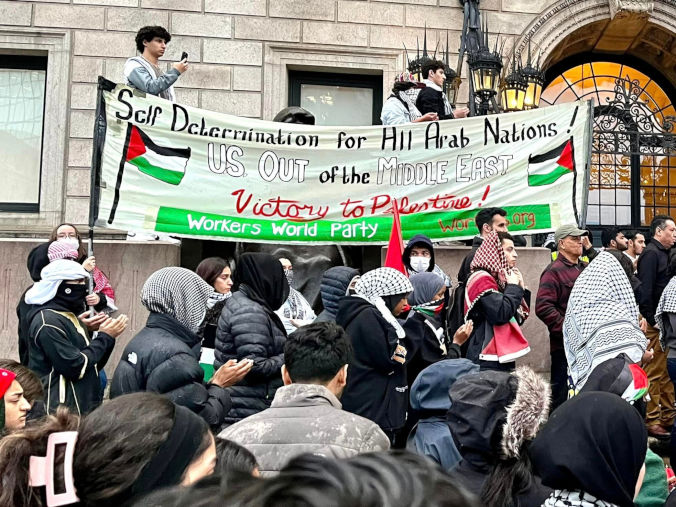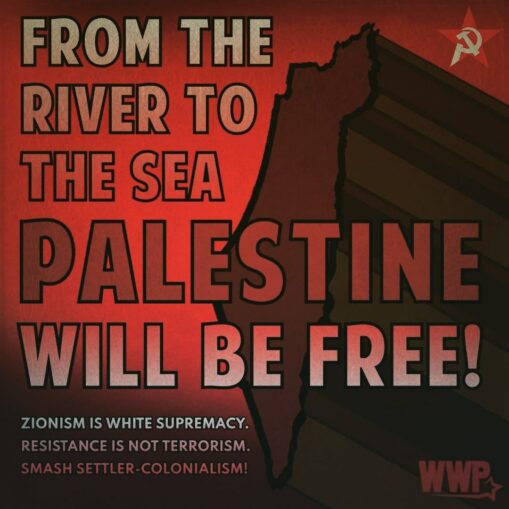

Boston protest, Oct. 17, 2023. WW Photo: Stevan Kirschbaum
Based on a talk given at an Oct. 19, 2023, Workers World Party meeting in New York City.
With any struggle for national liberation, the role of violence of the oppressed versus violence of the oppressor becomes a debate within the worldwide movement. This debate has occurred for many generations starting with the Paris Commune in 1871, when the workers and the poor of Paris dared to seize state power for 72 days to challenge the repressive rule of the dominating French bourgeoisie.


WW Graphic: Arjae Red
Although the workers and the poor were eventually defeated, these important lessons were examined by Karl Marx’s “The Civil War in France.” Marx’s work helped lay the basis for Vladimir Lenin’s “State and Revolution,” explaining the role of the repressive state and the triumph of the Soviet Union. There have been other important struggles where the issue of violence became a central question in Vietnam, Cuba, Chile, Angola, People’s Korea and elsewhere, along with rebellions of the oppressed inside the U.S.
As Marxists, we don’t view this question of violence as one of morality or in isolation, which pacifists and liberals tend to do. It is integral to the class struggle that goes to the heart of which side you are on — the side of the oppressor or the side of the oppressed; the side of the haves or the have-nots; the side of the working class or the side of the bosses.
It boils down to supporting oppressed peoples who have been superexploited by capitalism and imperialism, not just for one day or one month or one year, but for decades and even for centuries. In the instance of the colonized Palestinians, it has been 75 years since the Nakba.
During the height of the anti-apartheid struggle in South Africa, there was a period when the Black masses and their representatives, like the African National Congress, tried to appeal to the racist regime for a transition of power with peaceful protests and other nonviolent actions. These appeals were drowned in blood with outright heinous massacres, most notably in the Black townships of Soweto in 1976 and Sharpeville in 1960, by the brutal apartheid police.
These terrorist attacks led to a shift in tactics by liberation forces who felt they had no other choice but to organize an armed wing of the anti-apartheid struggle to fight force with force for both survival and social change. This significant decision was made with the understanding that any armed resistance would be a defensive one because the apartheid regime had at its disposal the most sophisticated weaponry from the West, including the U.S. The guerrilla fighters in South Africa had to rely on going underground to retrieve arms from socialist countries like the former Soviet Union, along with military assistance from socialist Cuba.
And as apartheid became more isolated and reviled worldwide, the armed resistance was labeled as “terrorism” by the apartheid regime and its imperialist allies in an attempt to demonize the struggle in the eyes of the world movement. But in the end, it backfired because the masses backed the armed struggle, which eventually led to the end of legal apartheid.
Palestinians challenge Zionism and imperialism
At this moment, the heroic uprising in Gaza, the West Bank, including Jenin and other areas in the Occupied Territories in Zionist Israel that began on Oct. 7 has taken the global center stage on the question of violence. This righteous struggle is on the front lines of challenging imperialism in the region and the world. It has been over 75 years since the settler colonial state of Israel was formed resulting in another form of apartheid.
During that time, the Indigenous Palestinian population has been bombed, brutalized, exiled to other parts of the world, and made refugees in their ancestral land by a racist, terrorist regime. This regime acts as a military outpost, doing the bidding of the imperialist West to control fabulous wealth and profits for mainly Big Oil interests.
Boston protest, Oct. 17, 2023. (WW Photo: Stevan Kirschbaum)
The Palestinians have used every means at their disposal to fight for their liberation, including general strikes, demonstrations, etc., where they were mowed down by Israel’s occupation forces and driven further out of their homes. No liberation forces can compete against bombs, tanks, helicopters and other high-powered military weaponry by just throwing rocks and bottles, or even hijacking airplanes — as justified and heroic as these tactics have been to help bring worldwide attention to the Israeli occupation.
So, once the Hamas group was democratically elected to represent occupied Gaza in 2006, an uncompromising organized resistance to the occupation was elevated, rooted in the First Intifada in the late 1980s.
Working-class forces worldwide must defend the right of Hamas to lead an armed struggle, despite any ideological differences with its leadership. Any form of resistance against Israeli occupation is also a blow against imperialism. This resistance also continues to break the decades-long isolation of those opposing Zionism, an isolation that has enjoyed the united support of the global ruling class and its bourgeois pundits, especially the media.
The rest of the masses in the Arab world, who have also suffered at the hands of the Zionist bullies for decades, view the Palestinian struggle as inspiration for struggling against their own puppet governments, which are complicit in submitting to Israel and imperialism. The only thing that can challenge a repressive state like Israel — a state founded on the wholesale theft of land, carried out with brutality and genocide — is armed resistance and the backing of the masses supporting that armed resistance.
Palestine is an exemplary demonstration of the right to self-defense of an oppressed people or nation, which any left force that views itself as revolutionary — especially if based in an imperialist country — must defend in order to strengthen global class solidarity.
A class view on violence
Sam Marcy, the late chairperson of Workers World Party, wrote three articles featured in the 1992 pamphlet “A Marxist Defense of the L.A. Rebellion,” when the Black and Latine communities rose up in a spontaneous rebellion following the acquittal of four racist white police officers charged with beating a Black motorist, Rodney King, almost to death in 1991. This heinous crime was caught on video before there was social media. The name of the following section is called “Marxism on violence.”
“After every stage in the struggle of the workers and oppressed people, there follows an ideological struggle over what methods the masses should embrace to achieve their liberation from imperialist monopoly capital. There are always those who abjure violence while minimizing the initial use of violence by the ruling class. They denounce it in words, while in deeds they really cover it up. That’s precisely what’s happening now.
“Yes indeed, they readily admit the verdict in the Rodney King beating was erroneous and unfair. But — and here their voices grow louder — ‘The masses should not have taken to the streets and taken matters into their own hands.’ Their denunciation of the violence of the ruling class is subdued and muffled — above all it is hypocritical, a sheer formality. It’s an indecent way of seeming to take both sides of the argument when what follows is in reality a condemnation of the masses.
“In times when the bourgeoisie is up against the wall, when the masses have risen suddenly and unexpectedly, the bourgeoisie gets most lyrical in abjuring violence. It conjures up all sorts of lies and deceits about the unruliness of a few among the masses as against the orderly law-abiding many. Marxism here again cuts through it all. The Marxist view of violence flows from an altogether different concept. It first of all distinguishes between the violence of the oppressors as against the responsive violence of the masses.
“Just to be able to formulate it that way is a giant step forward, away from disgusting bourgeois praise for nonviolence. It never occurs to any of them to show that the masses have never made any real leap forward with the theory of nonviolence. Timidity never made it in history. Indeed, Marxists do prefer nonviolent methods if the objectives the masses seek — freedom from oppression and exploitation — can be obtained that way. But Marxism explains the historical evolution of the class struggle as well as the struggle of oppressed nations as against oppressors.” (At workers.org/book/a-marxist-defense-of-the-l-a-rebellion/)
From the river to the sea, Palestine will be free!
May 19, 2025, will mark the 135th birthday of the great Vietnamese leader Ho Chi…
Philadelphia Honoring the 11 people murdered by the state when they dropped a bomb on…
The centennial of the birth of Malcolm X, also known as El-Hajj Malik El-Shabazz, is…
On May 11, which was Mother’s Day this year in the U.S. and several other…
Philadelphia On Mother’s Day 2025, May 11, Families for Ceasefire Philly and over 20 local…
North Philly Peace Park gathering After a federal court hearing on an anti-immigration bill early…